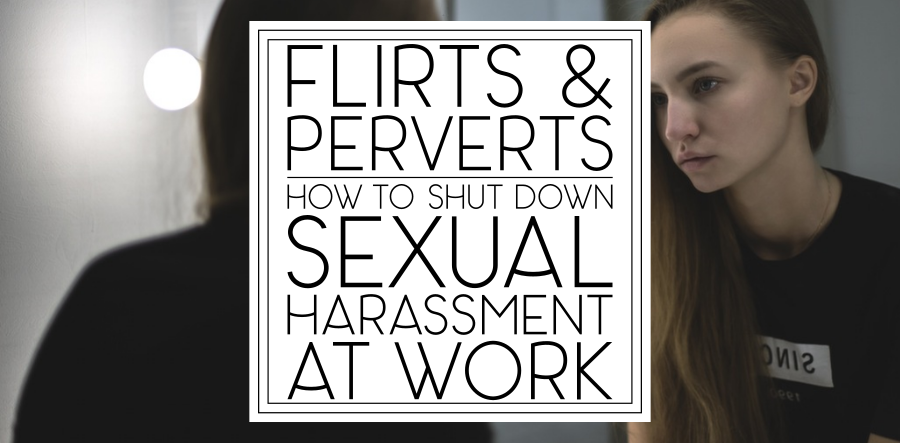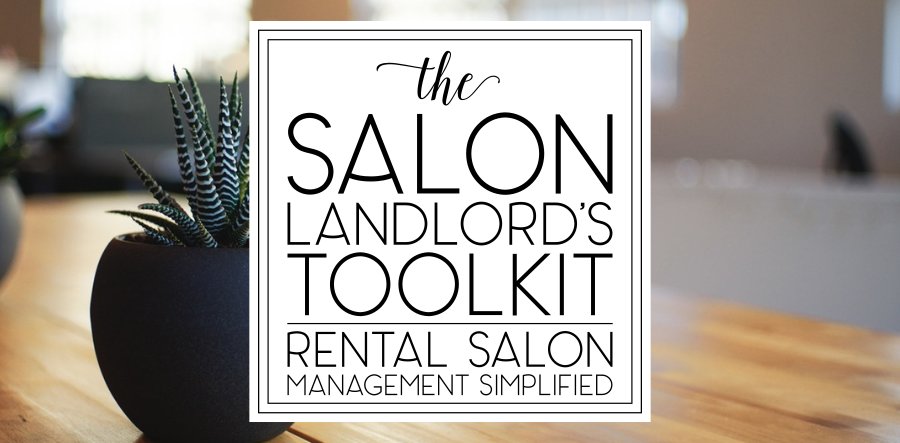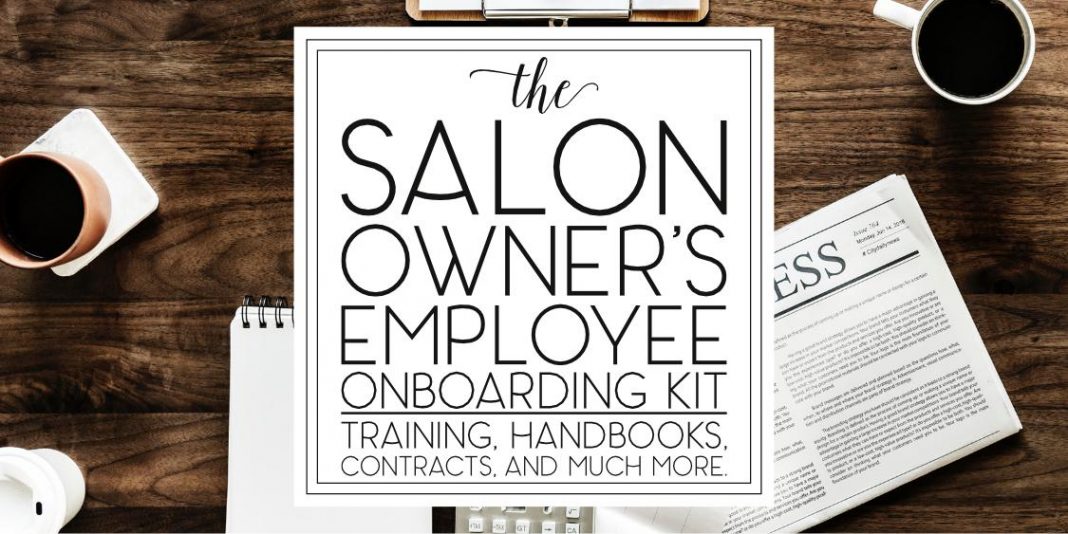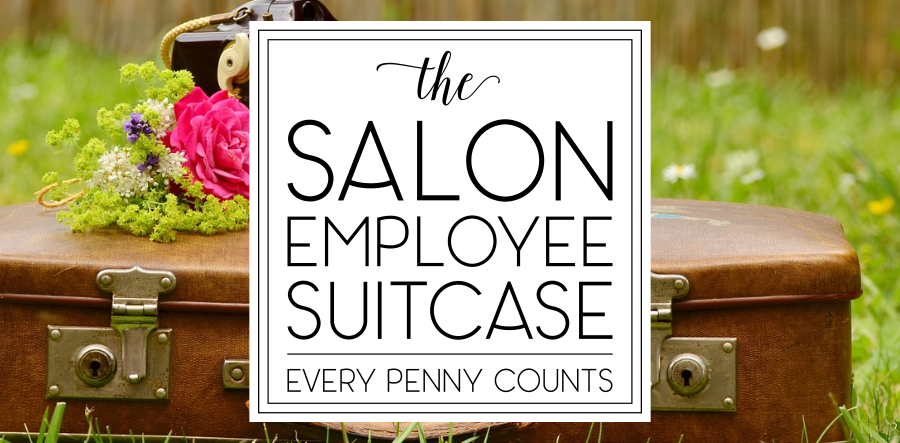Sexual harassment at work takes many different forms. For us women, it’s the male client who leans forward suddenly during the shampoo so his face is brushing against our breasts. He’s the one who’s always asking for our phone number, pleading with us to go out to dinner with him, or draping his hands over the armrests of the chair so he “accidentally” touches our thighs when we’re trimming his sideburns. For male professionals, it’s the raunchy female client who is a little too interested in your sex life, comments on how great your ass looks when you bend over to pick up a dropped comb, or who tells you exactly what she’d do with you if she weren’t married.
Regardless of your gender, most of us have had to deal with a client who gets a little too physical–hugging, kissing, and/or groping at us when they arrive or right before they leave.
Some forms of sexual harassment are more subtle. In those cases, the harasser may not realize what they’re doing has the potential to make you uncomfortable. For example, it’s not abnormal for clients to complement our appearance at work, commenting on our bodies, hair, skin, or makeup. A client who tells you how attractive you are every time they see you may not have any sexual intent or motivation, but if the statements are giving you a weird vibe, you’ll have to tell them to stop.
Because of the social nature of salon businesses, many clients believe it’s okay to treat professionals like sex objects. Some professionals also believe it’s okay to objectify one another.
It’s not okay–it’s unprofessional, degrading, and inappropriate.
Sexual advances and harassment can be intimidating, leaving an embarrassed professional in an uncomfortable position, usually in front of a public audience. In this post, I’ll tell you why it’s important to discourage harassment from the beginning, how to immediately shut down inappropriate behaviors, and how to do both without being unprofessional.
Listen to the article here!
Deterring Harassment
1.) Avoid implied invitations. The way you interact with people will influence how they’ll interact with you. If you behave flirtatiously, they will respond flirtatiously. People are not mind readers. You cannot expect a client or coworker to understand that your words and actions are essentially meaningless banter, so don’t display flirtatious behavior. Don’t model anything you don’t want them to emulate, or you’ll end up with a confused (and likely hurt) client or coworker when you draw the line.
2.) Draw a hard line. Often, I’ve seen professionals laugh at jokes that weren’t funny and allow commentary and touching that wasn’t appropriate. Later, these same employees would be in the back room talking about how “gross” the client was and claiming they wouldn’t accept the client again. I’ve also heard professionals tell their harassed coworkers to “get over it” and “play along,” excusing the harassment by saying, “it comes with the territory.” (A coworker of mine actually encouraged me to be flirtatious because male clients would tip me more.)
Sexual harassment isn’t something any professional should be expected to tolerate as part of providing good customer service.
Stop being accommodating with people who step out of line. You aren’t obligated to “be a good sport.” Any and all advances must be clearly declined. Long gone are the days when women were expected to smile sweetly and silently allow themselves to be objectified. Male professionals–you aren’t expected to tolerate harassment either.
There’s nothing unprofessional about putting an immediate halt to bad behavior.
3.) Don’t answer personal questions, volunteer personal information, or allow inappropriate conversations to occur.
“So, what’s your deal? Are you in a relationship?”
“I’ll bet someone like you is into all kinds of wild things in the bedroom. Am I right?”
“We ended up doing it in her car in the church parking lot. What about you? Where’s the craziest place you’ve ever had sex?”
These are real things I’ve heard people say to professionals at work. It’s one thing if you and a close friend are swapping stories on your own time, but that’s not what we’re talking about here. When a client, coworker, or employer intrudes into your personal life in a way that makes you uncomfortable, do not respond with anything other than an immediate refusal to allow the discussion to continue.
Shutting it Down
1.) Stop what you’re doing and have the harasser look directly at you. Don’t attempt to have this discussion while you’re working, and don’t talk to them through a mirror. Make sure they are focused on you. Eye contact matters.
2.) Be assertive and straightforward. Don’t be coy or turn the discussion into a lighthearted joke. In this instance, you will need to be firm and confident. Once the client is facing you, say what you need to say–nothing more, nothing less.
Don’t apologize. you are the one who has been wronged; you are not the one who should be saying sorry.
3.) Don’t back down or allow the harasser to dismiss you.
“Can’t you just take a complement?”
“It’s not a big deal. Just relax.”
“Calm down. You’re overreacting.”
Never let a harasser flip the script on you. You didn’t do anything wrong; they did.
You are a professional. The salon is your workplace. You’re not there to be objectified.
Some people, when called to task for their inappropriate behavior, will do whatever they can to diminish what they’ve done and deflect the blame onto anyone or anything other than themselves.
“I was only kidding around.”
“I was just giving you a complement.”
“I like you, is that so wrong?”
The first thing you need to understand about sexual harassment is that the harasser’s intentions are completely irrelevant. There is no excuse or justification for it. This isn’t about their intentions; it’s about making sure they understand that you consider their behaviors unacceptable.
4.) Don’t talk about your feelings. When you’re having this discussion at work in a room full of people, don’t get emotional.
Emotional Responses:
“When you talk to me like this, it makes me feel…”
“It upsets me when you…”
“You’re making me feel uncomfortable…”
Straightforward Response: “Those comments/behaviors are inappropriate and unappreciated. If you don’t stop, [CONSEQUENCE].”
5.) Your refusal is enough. No means no. You don’t owe anyone an explanation, so don’t volunteer one or cater to a harasser’s demand to provide one. Your relationship status (“I’m taken,”) and sexual preference (“I’m gay/straight,”) aren’t anyone’s business.
You aren’t interested. You won’t tolerate it. That’s all they need to know.
6.) Stick to the script. Tell the harasser to stop, lay down your consequences, and follow through with them if they don’t comply.
But what consequences should you present? Can you kick a client out of your chair for harassing you if you’re an employee? How can you punish a coworker who is sexually harassing you? What if the harasser is the boss?
Sexual harassment is a human rights violation.
For a client, the consequence is immediate dismissal. Nobody has the authority to force you to endure sexual harassment–not your manager or the salon owner. Regardless of your position in the company, you have the right to refuse service to anyone who violates your rights, and this is a human rights issue. Employers don’t have the power to strip you of your right to feel safe and comfortable at work. No employer can force you to endure humiliation or intimidation at the hands of another person. As a matter of fact, it is an employer’s legal obligation to protect you from those abuses.
For a coworker, the consequence is a formal complaint to management, or to the salon owner. If the person harassing you is the owner, the consequence is much more severe–an official complaint to state or federal authorities.
Here’s what this discussion looks like for each situation:
Client: “That’s enough. Your comments/behaviors are inappropriate and unappreciated. If you don’t stop, you will need to leave.”
Coworker: “I won’t tolerate your comments/behaviors any longer. If you continue, I will file an official complaint with the manager/owner.”
Supervisor/Employer: “Your comments/behaviors are offensive, unprofessional, and unwelcome. It’s a violation of my civil rights and I won’t tolerate it. If you don’t stop, I will file a complaint with the EEOC.”
I cannot stress the importance of your posture, tone, facial expression, and eye-contact here. The words you say mean nothing if you say them with a smile, or while looking down at the floor, or mutter them meekly.
Sit up or stand up straight, look the harasser in the face, and speak clearly and decisively.
Never apologize, don’t allow them to intimidate you or dismiss your valid complaints, and stop them when they try to make excuses. Just hold your hand up and say, “You don’t need to explain yourself any more than I do, just don’t do it again.”
When the Harasser is a Superior or Coworker
Fun fact: Sexual harassment in the workplace is illegal. Sexual harassment is a form of sexual discrimination that constitutes a violation of the Civil Rights Act of 1964.
There are two types of company harassment:
- Quid pro quo: “If you submit to my conduct or requests (whether those requests are implicit or explicit), I’ll reward you.” Quid pro quo harassment occurs with a superior or coworker links your acceptance of their advances to a professional benefit, or threatens a professional consequence if you don’t acquiesce.
- Hostile work environment: The coworker or superior’s harassment interferes with your work performance or creates an environment that is uncomfortable.
The process for handling these situations is a bit different than when dealing with a client. After you’ve shut it down, you’ll need to do the following:
1.) Take notes. Document everything and be very specific. Write down the date and time, what was said or done, and where it happened. Also list who was present and what you did about it.
2.) Tell a superior. If the harasser is a coworker and speaking to them directly doesn’t get them to stop, go directly to a manager or the salon owner. Tell them about the discussion (or discussions) you’ve had with the harasser, and explain to them that you expect something to be done about it, since the discussion has not yielded any results.
When you discuss any harassment with your employer, make it very clear that it is their problem to handle.
Stick to the legalities–“I am being sexually harassed by this person. I have had a discussion with them about it, during which I told them to stop. They have not and continue to disrupt my work day and my work environment. Legally, it is your responsibility as the company owner to end this harassment. If you fail to do so, I will file a complaint with the EEOC and let them handle it.”
If the harasser is your superior and speaking with them directly hasn’t worked, don’t feel obligated to have that discussion twice. They’re adults. Once is enough. Go directly to the next step.
3.) File a complaint with the EEOC. You don’t need an attorney or to pay a bunch of fees–just go to the EEOC website and follow the instructions for filing a complaint. If you’re not sure whether or not you want to file a complaint, contact the EEOC by phone to speak with a counselor and have them advise you.
Don’t delay. You have six months from the date of the activity to file a charge.
Once the EEOC receives your complaint, they’ll contact your employer to let them know that you’ve filed a complaint, and then they’ll begin investigating. These investigations go one of the following ways:
- The EEOC works with the employer to settle the complaint through a mediator. If that doesn’t work,
- The EEOC may file a lawsuit in federal court, or
- The EEOC may grant you a “right-to-sue” letter, allowing you to file a lawsuit in civil court.
Should you be fired or demoted after refusing or reporting sexual harassment, you mayhave been retaliated against. Retaliation is a violation of a person’s rights under Title VII.
You can learn more about retaliation here.
When to Call the Police
There’s a distinct difference between flirting, harassment, and stalking, but some people have a hard time determining when to get law enforcement involved.
Turning down a harasser’s advances should be enough, but when it isn’t, take it seriously.
The Department of Justice defines stalking as “a pattern of repeated and unwanted attention, harassment, conduct, or any other course of conduct directed at a specific person that would cause a reasonable person to feel fear.”
The definition of sexual harassment is intentionally broad so that it includes a wide range of subtle and overt behaviors, but the definition of stalking is relatively narrow and pointed. Harassment at work can be uncomfortable, humiliating, and (at its worst) can certainly intimidate and inspire fear in the victim, but stalking behaviors ratchet that fear to an extreme level. Immediate law enforcement intervention is necessary.
Examples of stalking behavior include:
- threats,
- persistent pursuit (following, waiting for the victim to arrive at a location, showing up at a victim’s home or workplace), and
- non-consensual communication (calls, texts, emails, gifts, social media contact).
Stalkers may harass a victim’s friends and family as well. Some will do whatever they can to find ways of injecting themselves into a victim’s life.
If you are being harassed to the degree that you are feeling anxious, fearful, or depressed, you need to speak out.
- Tell family, friends, coworkers, and–if you have children–anyone who cares for them (schools, daycares, and babysitters),
- File a report with the police and seek a protective order,
- Keep detailed records of everything, and
- Save call logs, text messages, emails, gifts, and voicemails from the person stalking you.
Take precautions:
- Keep a cell phone handy at all times,
- Invest in some pepper spray and a loud personal safety alarm (yeah, seriously), and
- Park near your coworkers and arrange to leave together at closing time.
In my career, I have seen many professionals endure harassment, and twice I’ve had to help employees shake clients who became unhealthily attached to them. I understand that for some people (particularly those who work in our industry and who tend to be more accommodating by nature), it can be really hard to speak out at work. If you’re struggling to handle it yourself, it’s okay to ask for help from a coworker or employer.
Owners, it’s your job to protect your professionals, so keep a close eye on younger employees who may not be capable of identifying harassment or asserting themselves against a harasser. Keep your ears open around LGBTQ professionals to ensure they’re not being subjected to ridicule, discrimination, or harassment at the hands of clients or coworkers. Whether the employee recognizes the inappropriate behavior, is taking it in stride, or is also participating in it doesn’t matter–if someone is acting in a way that isn’t proper, it’s your legal and moral obligation to put a stop to it.
I don’t have a new downloadable ready for you (yet), but I have added this document to The Salon Employee Suitcase. My next downloadable is in development and is nearly done, so keep an eye out for its release next week. If you want to see my entire selection of downloadables, check out The Store here. If you liked what you read and want to read more, you may like my book, The Beauty Industry Survival Guide.
What about you? Have you been harassed at work by a client, coworker, or boss? How did it make you feel and what did you do about it? Tell us about it in the comments. (You can post anonymously if you’d like.) Share your story if you feel comfortable doing so. You may help another professional who is going through the same thing.









5 Responses
My girlfriend works at a subway and she says a co worker of hers keeps staring at all the girls butts there and it’s making her uncomfortable what should I do
The article tells you exactly what to do. Read it. She needs to report the harassment–either to someone at Subway HR or to the EEOC.
This article is really helpful. It helps in other situations outside the workplace as well. For a while I really didn’t know what to do and the people I asked for advice did not give good advice at all. I’m glad I came across this.
Im an apprentice in a small town salon. Because I was/am trying to build a clientele, when i first started cutting hair, I put up with a lot; rude clients, clients telling me how to do my job, clients who made me feel extremely uncomfortable, etc. All because I was scared of losing the small clientele I had. One gentleman (if i can even call him that) in particular was extremely suggestive throughout a service, making inappropriate comments about what i was wearing, my body, etc. At first I thought i was just interpretting his comments differently than he meant them, then as he was leaving he motioned for me to come closer and told me, with a wink, that I “would look great in knee-high leather boots”. I was so shocked that i couldnt say a word as he left. It was the most uncomfortable and degrading thing I had ever experienced, and I was so diappointed in myself for not trusting my gut and taking action during the service when it had first happened. So glad to see articles like this, and to have the tools to equip myself against this kind of inappropriate behaviour in the future.
I am so sorry this happened to you. Unfortunately, this shit is still pretty common. I’m glad the article helped and hopefully the next time some creep tries to objectify you, you will feel more empowered to tell them what they need to hear. <3